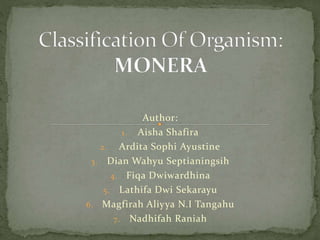
MONERA
- 1. Author: 1. Aisha Shafira 2. Ardita Sophi Ayustine 3. Dian Wahyu Septianingsih 4. Fiqa Dwiwardhina 5. Lathifa Dwi Sekarayu 6. Magfirah Aliyya N.I Tangahu 7. Nadhifah Raniah
- 2. Empires Kingdom Organism Eukaryote (have nucleus membranes) Protista Fungi Plantae Animalia Prokaryote (don’t have nucleus membranes) MONERA Source: en.wikipedia.org
- 4. Monera are organisms that do not have a cell nucleus membrane. Kingdom has two major groups of organisms, namely bacteria and cyanobacteria. Both are included in prokaryotes and unicellular organisms. Monera reproduce by dividing the mselves and there is also aspore-forming Monera. The formed spore is called ENDOSPORE Source: munawarsmanti.blogspot.com
- 5. The taxon Monera was first proposed by Ernst Haeckel as phyla in 1866; later, the taxon was raised to the rank of the kingdom in 1925 by Eduard Chatton, gain public acceptance, and the latter is generally accepted classification of the mega-taxon Monera was five kingdom system classification defined by Robert Whittaker in 1969. In the three-domain system of taxonomy, which was founded in 1990 and reflects the evolutionary history of life as currently understood, the organism is found in the kingdom Monera divided into two domains, Achaeans and bacteria (the eukaryotes as a third domain). The next is a paraphyletic taxon Monera. The term "moneran" is the informal name of a member of this group and are still sometimes used (as the term "prokaryote") to indicate whether a domain member
- 6. Bacteria, despite their simplicity, contain a well-developed cell structure which is responsible for many of their unique biological properties. Many structural features are unique to bacteria and are not found among archaea or eukaryotes. Because of the simplicity of bacteria relative to larger organisms and the ease with which they can be manipulated experimentally, the cell structure of bacteria has been well studied, revealing many biochemical principles that have been after applied to other organisms.
- 7. Source: Suyitno A., Sukirman. Biology, For Junior High School Year VII, Yudhistira
- 9. VS Source picture: google.co.id
- 10. Perhaps the most well known bacterial adaptation to stress is the formation of endospores. Endospores are bacterial survival structures that are highly resistant to many different types of chemical and environmental stresses and therefore enable the survival of bacteria in environments that would be lethal for these cells in their normal vegetative form. It has been proposed that endospore formation has allowed for the survival of some bacteria for hundreds of millions of years (e.g. in salt crystals) although these publications have been questioned. Endospore formation is limited to several genera of Gram-positive bacteria such as Bacillus and Clostridium. It differs from reproductive spores in that only one spore is formed per cell resulting in no net gain in cell number upon endospore germination. The location of an endospore within a cell is species-specific and can be used to determine the identity of a bacterium Source: id.wikipedia.org
- 11. Cyanobacteria, Cyanophyceae, blue-green algae, and blue-green bacteria is a phyla autotrophic bacteria. Its fossil has found age 3.8 billion years B.C. This group of bacteria is one of the largest and important in the earth. Source: id.wikipedia.org
- 12. Nostoc is Cyanobacteria has the form of colony phlegm ball that adhere, so that the shape would be lone circle phylament like necklace. Nostoc reproduce by fragmentize Anabaena is a genus of Cyanobacteria that the form of its self like nostoc. The difference is anabaena can symbiotic with the root of plants. Anabaena reproduce with spore Gleocapsa is a genus of Cyanobacteria that can found on wet stone or plants pot. Its cell has form of circle or oval with color green and blue spread in around a cell wall Oscillatory has the form of phylament with tighten and formed by mug-cell. It’s excessively found in pond and pure water Rivularia is a genus of Cyanobacteria that has form of stimulus Source: munawarsmanti.blogspot.com
- 13. Rivularia Gleocapsa Oscillatory Anabaena Nostoc
- 14. There are two different ways of grouping bacteria. They can be divided into three types based on their response to gaseous oxygen. Aerobic bacteria require oxygen for their health and existence and will die without it. Anaerobic bacteria can't tolerate gaseous oxygen at all and die when exposed to it. Facultative anaerobes prefer oxygen, but can live without it. The second way of grouping them is by how they obtain their energy. Bacteria that have to consume and break down complex organic compounds are heterotrophy. This includes species that are found in decaying material as well as those that utilize fermentation or respiration. Bacteria that create their own energy, fueled by light or through chemical reactions, are autotrophy.
- 15. Any Question ??
